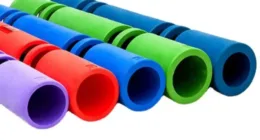Introduction
Leatherwork is an age-old craft that blends artistry, skill, and functionality. Whether you’re a beginner or looking to refine your techniques, Leatheling offers a wealth of information to help you master the art of leatherworking. This comprehensive guide will provide you with essential tips and tricks, tools, and techniques to elevate your leatherwork projects. From choosing the right materials to finishing your creations, this article will equip you with the knowledge to succeed in leather crafting.
Understanding Leather
Types of Leather
Before diving into leatherwork, it’s crucial to understand the different types of leather available. Each type has unique characteristics and uses:
- Full-Grain Leather: This is the highest quality leather, made from the top layer of the hide. It retains the natural grain and is known for its durability and ability to develop a beautiful patina over time.
- Top-Grain Leather: Slightly less durable than full-grain, top-grain leather is sanded and treated to remove imperfections. It’s softer and more pliable, making it ideal for various projects.
- Genuine Leather: This term can be misleading. Genuine leather is made from the lower layers of the hide and is less durable than full-grain and top-grain leather.
- Suede: Made from the inner layer of the hide, suede has a soft, velvety texture. It’s less durable and more prone to staining but adds a unique aesthetic to projects.
- Bonded Leather: This is made from leftover scraps of leather, bonded together with polyurethane. It’s the least expensive option but also the least durable.
Choosing the Right Leather for Your Project
Selecting the right type of leather depends on your project’s requirements:
- Durability: For items like belts and bags, opt for full-grain or top-grain leather.
- Softness: For clothing or wallets, consider top-grain leather or suede.
- Cost: If you’re on a budget, bonded leather can be a viable option, though it won’t last as long.
Essential Tools for Leatherworking
Having the right tools is critical for successful leatherwork. Here’s a list of essential tools you’ll need to get started:
1. Cutting Tools
- Rotary Cutter: Ideal for cutting straight lines and curves with precision.
- Utility Knife: Useful for smaller cuts and detailed work.
- Leather Shears: Designed specifically for cutting leather, these shears provide clean edges.
2. Punching Tools
- Leather Hole Punch: Necessary for creating holes for stitching or rivets.
- Chisels: Great for making evenly spaced holes and can be used for decorative effects.
3. Stitching Tools
- Needles: Use heavy-duty needles designed for leather, such as harness needles.
- Thread: Polyester or nylon thread is preferred for durability.
- Awl: A sharp tool for making starter holes for stitching.
4. Finishing Tools
- Burnishing Tools: Used to smooth the edges of leather and give a polished look.
- Edge Tools: For trimming and finishing the edges of your projects.
5. Adhesives and Fasteners
- Contact Cement: Ideal for bonding leather pieces together.
- Rivets and Snaps: Useful for closures and decorative elements.
Basic Techniques for Leatherwork
1. Cutting Leather
Cutting leather accurately is vital for achieving clean lines. Here are some tips:
- Use a Sharp Blade: A sharp blade ensures clean cuts and minimizes fraying.
- Measure Twice, Cut Once: Take your time measuring and marking before cutting.
- Cut on a Self-Healing Mat: This protects your workspace and prolongs the life of your blade.
2. Punching Holes
Creating holes for stitching or fasteners should be done with precision:
- Mark Hole Placement: Use a ruler and pen to mark where you need holes.
- Use a Hole Punch: Apply even pressure for clean holes.
- Practice on Scraps: If you’re unsure, practice on scrap leather to perfect your technique.
3. Stitching Techniques
Stitching is a fundamental skill in leatherwork. Here are popular stitching techniques:
- Running Stitch: Simple and effective for most projects. Pass the needle through each hole in a back-and-forth motion.
- Backstitch: Provides extra strength, ideal for seams that experience stress.
- Saddle Stitch: A robust technique using two needles, creating a strong and durable seam.
4. Finishing Edges
Finishing the edges of your leather project gives it a professional look:
- Trim Edges: Use an edge tool to create a uniform edge.
- Burnish: Apply moisture or a burnishing compound and use a burnishing tool to smooth the edge.
- Dye or Paint: Consider adding dye or paint for a polished finish.
Tips for Mastering Leatherwork
1. Start Small
If you’re new to leatherwork, begin with small projects like wallets or keychains. This allows you to practice basic techniques without overwhelming yourself.
2. Invest in Quality Materials
While it might be tempting to save money on materials, investing in high-quality leather and tools will yield better results and a more enjoyable crafting experience.
3. Learn from Others
Join leatherworking communities online or attend local workshops. Sharing tips and techniques with other leatherworkers can provide valuable insights and inspiration.
4. Practice Patience
Leatherwork requires time and patience. Don’t rush through projects; take the time to learn each technique thoroughly.
5. Experiment with Designs
Don’t be afraid to experiment with different designs, colors, and textures. Leather is a versatile medium, and personalizing your projects can lead to unique creations.
Advanced Techniques for Experienced Leatherworkers
Once you’ve mastered the basics, consider exploring advanced techniques to take your leatherwork to the next level.
1. Leather Dyes and Finishes
Experimenting with dyes can transform your leather projects:
- Water-Based Dyes: Easy to use and clean up, these dyes are great for beginners.
- Alcohol-Based Dyes: Provide vibrant colors but require careful application.
- Finishing Products: Use sealers and conditioners to protect your finished projects and enhance durability.
2. Carving and Stamping
Adding decorative elements can elevate your leather creations:
- Leather Carving: Use specialized tools to carve designs into the leather surface.
- Stamping: Leather stamps allow you to imprint designs, logos, or patterns onto your projects.
3. Advanced Stitching Techniques
Once you’re comfortable with basic stitching, try your hand at:
- Laced Edges: Adds a decorative touch to the edges of bags and belts.
- Decorative Stitching: Incorporate various colors and patterns for a personalized finish.
Troubleshooting Common Leatherworking Issues
1. Uneven Cuts
If your cuts aren’t straight, ensure your cutting tools are sharp and use a straight edge as a guide.
2. Frayed Edges
Fraying can occur if leather is cut too aggressively. Use a sharp blade and ensure you’re cutting with the grain.
3. Poor Stitching
If stitches are uneven, check your hole spacing and ensure you’re using the correct technique. Practicing on scrap pieces can help improve your consistency.
Conclusion
Mastering leatherwork is a rewarding journey that combines creativity, skill, and craftsmanship. Leatheling provides the essential tips and tricks needed to enhance your leatherworking experience, from understanding the types of leather to perfecting advanced techniques.
By investing time in practice and continually learning, you can create stunning leather projects that reflect your personal style and craftsmanship. Whether you’re making gifts, accessories, or custom items for yourself, the world of leatherwork offers endless possibilities.
Embrace the art of leatherworking, and let your creativity shine. With dedication and passion, you can become a skilled leatherworker, producing high-quality items that stand the test of time. Happy crafting!









